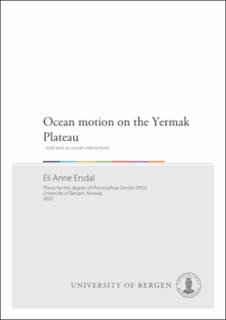| dc.contributor.author | Ersdal, Eli Anne | |
| dc.date.accessioned | 2020-12-14T07:49:18Z | |
| dc.date.available | 2020-12-14T07:49:18Z | |
| dc.date.issued | 2020-11-02 | |
| dc.date.submitted | 2020-10-15T08:29:32.192Z | |
| dc.identifier | container/97/27/58/07/97275807-1d7b-4400-ba56-ac2c35a5dab9 | |
| dc.identifier.isbn | 9788230843826 | |
| dc.identifier.isbn | 9788230842744 | |
| dc.identifier.uri | https://hdl.handle.net/11250/2718965 | |
| dc.description.abstract | This study focuses on the tidal and atmospheric dynamics controlling the overflow of warm Atlantic Water, crossing over the Yermak Plateau, which can be seen as a doorstep to the Arctic Ocean. The Arctic conditions are changing due to the general global warming, and in order to make good predictions of the future climate north of Svalbard and further into the Arctic Ocean, a good understating of the dynamics controlling the overflow is essential. The Yermak Plateau is known for enhanced diurnal tides caused by topographically trapped waves (TTW). A numerical shelf model has been set up for the southwestern side of the plateau to investigate when the TTW near the diurnal frequency become resonant with zero group velocity, meaning that the diurnal energy does not radiate out of the region, but will accumulate along the slope. The model inputs are slope steepness, background current and stratification, and the result indicates that the group velocity of the TTW near the diurnal frequency becomes zero when the background current is strong, i.e. during winter. Four moorings have measured ocean currents and ocean bottom pressure (OBP) on top of the plateau and the data revealed significant monthly and fortnight tidal periods during winter. The low-frequency Lunar Monthly, Mm, and the fortnightly, MSf, are astronomically forced, but their potentials are weak, especially the potential of MSf.
Therefore, we suggest that the observed enhancement of Mm and MSf on top of the plateau during winter, is caused by an energy contribution from the diurnal tides. The superposition of Mm and MSf have been termed the Nonlinear Yermak Tidal Overflow (NYTO), and reached a maximum speed of 15 cm s$^{-1}$ in February 2016. From December to May, the mean volume transport was 1.1 Sv by the NYTO alone.
The four moorings located on top of the plateau have been set up to target the Svalbard Branch (SB) and the Spitsbergen Polar Current (SPC). After evaluating the tidal effect on the Atlantic Water flow across the plateau, these ocean data were coupled with high resolution atmospheric hindcast data to get a deeper understanding of the air-ocean dynamics. The volume transports in the SB and the SPC calculated from the OBP data were correlated with the wind stress curl over Svalbard. As a negative wind stress curl is linked to surface water convergence, southerly alongshore winds stress in the Fram Strait will generate onshore Ekman transport resulting in a convergence zone with a negative wind stress curl on the shelf. This effect steepens the sea surface tilt over the slope, accelerating the ocean current along the slope. In the opposite case, a northerly wind stress generates a westward Ekman transport, weakening the sea surface tilt and decreasing the current speed. Satellite altimetry measurements from 1994 to 2018 were included to investigate the interannual and decadal variations of the oceanic flow passing over the plateau. To validate the performance of satellite altimetry in the SB north of Svalbard, the calculated current fluctuation from satellite altimetry were compared with the current fluctuation derived from the OBP data. Satellite altimetry was found to be useful in calculating the volume transports in winter when the water column has constant density. The winter volume transports from 1994 to 2018 were calculated in three sections, the barotropic West Spitsbergen Current (WSC core), the SB, and the Yermak Pass Branch (YPB) with mean values of 1.4 Sv, 1.1 Sv, and 1.4 Sv, respectively. The flow in the WSC core and the SB correlated
with each other throughout the winter season and with the southerly wind stress on the West Spitsbergen Shelf. The flow in the YPB correlated with the northerly wind stress on the West Spitsbergen Shelf and were anti-correlated with the WSC core and the SB from March to May. | en_US |
| dc.language.iso | eng | en_US |
| dc.publisher | The University of Bergen | en_US |
| dc.relation.haspart | Paper I: Ersdal, E. A. and F. and Nilsen. (2020) Topographically trapped waves along an Arctic continental shelf in resonance with diurnal tidal frequencies. Not available in BORA. | en_US |
| dc.relation.haspart | Paper II: Ersdal, E. A., F. Nilsen, and T. Gammelsrød. (2020) On nonlinearly enhanced low-frequency tides over the Yermak Plateau. Not available in BORA. | en_US |
| dc.relation.haspart | Paper III: Nilsen, F., E. A. Ersdal, and R. Skogseth (2020) Atlantic- and Arctic Water transport across the Arctic Sill - Variability in the poleward current branches across the Yermak Plateau. Not available in BORA. | en_US |
| dc.relation.haspart | Paper IV: Ersdal, E. A., F. Nilsen, R. Skogseth, and E. Falck (2020) Winter volume and heat transport into the Arctic Ocean from 1994 to 2018 calculated from satellite altimetry. Not available in BORA. | en_US |
| dc.rights | Copyright the Author. All rights reserved | |
| dc.title | Ocean motion on the Yermak Plateau : - tidal and air-ocean interactions | en_US |
| dc.type | Doctoral thesis | en_US |
| dc.date.updated | 2020-10-15T08:29:32.192Z | |
| dc.rights.holder | Copyright the Author. | en_US |
| dc.contributor.orcid | 0000-0001-6667-0000 | |
| dc.description.degree | Doktorgradsavhandling | |
| fs.unitcode | 12-44-0 | |
